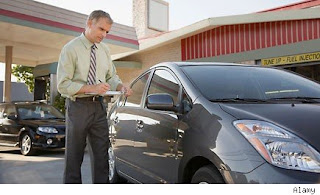Don't want to get locked into a demanding contract or high monthly fees? Then just pay as you go! It's a popular way to finance a mobile phone, but now you can also pay as you go for your car insurance.
For certain people, a pay-as-you-go insurance plan can make a lot of sense and save a lot of money. After all, car insurance is a major expense for many Americans.
The national average annual premium for sedans is about $1,000, though that can vary by a wide margin. For example, in New Jersey, which has some of the highest rates in the nation, the average annual car-insurance premium is about $2,500. In Michigan, it's about $2,000.
Whether you pay $2,500, $1,000, or even $600 per year, car insurance can really pinch a budget, and it's especially frustrating if the insured driver doesn't even take the wheels for a spin very much. That's where "pay-as-you-drive," or PAYD, insurance comes in.
How It Works
Pay-as-you-drive plans involve installing a monitoring device onto your vehicle that typically records when you drive, how far you go, and also how often or hard you brake. As a result, it's your own personal driving characteristics that dictate the premium you're quoted. (Some plans, now or later, will let parents monitor and even restrict teenage drivers.)
In many ways, this new offering improves on the traditional model of car insurance. The old-fashioned approach would price your premium based on factors such as your age, gender, marital status, and even your credit rating. Young, single men, for example, tend to be quoted the highest rates, but many young, single men are careful and responsible drivers, penalized for the behavior of their peers.
Those who stand to gain the most will drive the fewest miles, ideally not at rush hour, and won't exhibit characteristics of aggressive driving, such as frequent or hard braking. Telecommuters and small-town residents are promising prospects.
Who Offers It
Right now, about eight of the top 10 car insurers now offer pay-as-you-drive coverage.
Progressive (PGR) calls its offering "Snapshot" and is offering drivers the chance to test it for free for one month. Its device is plugged into your dashboard, and you're able to review its data online. When the month is up, Progressive will use that data to quote you a price for coverage. Other systems don't use a plug-in dashboard device, but rely instead on certified odometer reading, or the cooperation of OnStar technology.
Allstate's (ALL) system is called "Drive Wise," and the company is offering customers who try it a one-time 10% discount just for doing so. State Farm recently expanded its PAYD coverage to about a dozen states, suggesting that those who drive the least might be able to save 40% and possibly even 50%. (It estimates that a typical driver who covers about 11,000 miles per year would save roughly 12% with a PAYD plan.) Hartford Financial Services (HIG) offers a TrueLane PAYD plan in about half a dozen states.
How Much Can You Save?
It's estimated that about 70% of those who try PAYD insurance will be able to save money with it -- and that savings can be as much as 30% of their regular premium.
Folks at the Brookings Institution have estimated that if everyone used PAYD insurance, two-thirds of households would save about $270 per car.
There are even broader benefits possible if all of America were to adopt PAYD insurance. Per the Brookings Institution: "We estimate driving would decline by 8% nationwide, netting society the equivalent of about $50 billion to $60 billion a year by reducing driving-related harms. This driving reduction would reduce carbon dioxide emissions by 2% and oil consumption by about 4%. To put it in perspective, it would take a $1-per-gallon increase in the gasoline tax to achieve the same reduction in driving."
Savings vs. Privacy
PAYD is not a perfect solution to the car-insurance challenge. One of the biggest knocks against it is that it invades your privacy. After all, the insurance company isn't going to just take your word that you only drove your Camry 23 miles in the last month.
As more data are collected under this new system, it will be possible to set rates more accurately, and more insurers will be likely to start offering PAYD. Progressive has reportedly collected 5 billion miles' worth of data already.
So the next time you renew your policy, give pay-as-you-drive insurance some consideration. Ask your insurer if it's offered and whether you can take it for a test-drive.
Longtime Motley Fool contributor Selena Maranjian, whom you can follow on Twitter, holds no position in any company mentioned. Click here to see her holdings and a short bio.
the source :http://www.dailyfinance.com/tag/car+insurance/




















